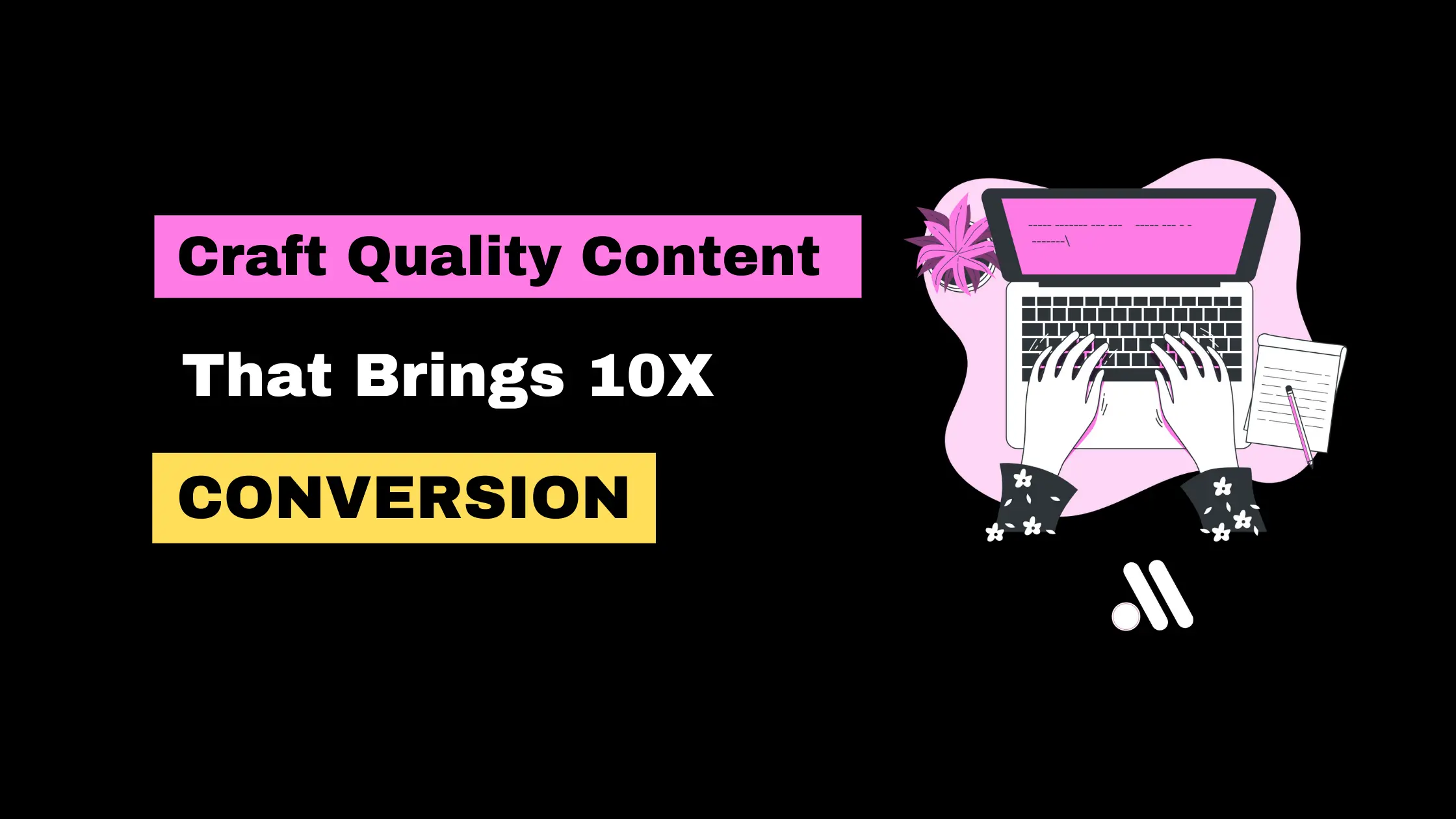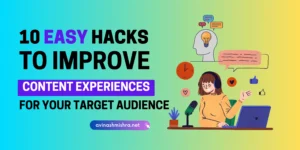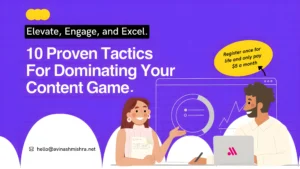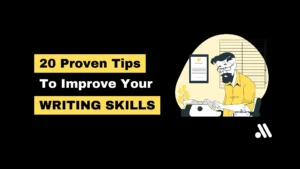Have you ever felt frustrated trying to create quality content that engages readers and drives results?
Many bloggers and business owners bang their heads trying to produce high-quality content.
But what makes content “quality” anyway and how to create it consistently?
In this post, I’ll share a simple step-by-step guide to creating quality content that converts readers and boosts your business. Let’s Dive In.
What Is Quality Content?
This question is worth its weight in a million dollars.
Crafting quality content is the key to more visitors, improved conversions, and reduced bounce rates.
But who sets the bar for content quality?
Your audience. Their search intent.
The quality of content is ultimately determined by the users, who possess varying search intents.
Nevertheless, all users share the characteristic of clarity regarding their desired information.
Crafting well-thought-out, readable, and engaging content is the path to creating high-quality content that satisfies both users and search engines, even though it requires an investment of time and effort.
Depending on the context, the term “quality content” can mean several things, but essentially, it refers to media, information, or additional resources that satisfy specific standards, including being accurate, engaging, valuable, and relevant.
Why Is Quality Content Important?
Gone are the days when you could spam blog posts and rank high in Google.
The algorithms used by Google are much better than ever at identifying low-quality content.
In fact, Google has confirmed a “helpful content update” that specifically targets low-quality pages.
If your overall content quality is poor, your rankings will tank.
So creating high-quality, valuable content is crucial for SEO success.
Above all, high-quality content adds genuine value to your audience. It makes their life better and solves their problems.
That increases brand loyalty and trust.
As marketing guru, Seth Godin says:
“Content marketing is the only marketing left.”
So if you want to grow your business today, quality content is essential.
Now let’s explore what “quality” really means…
What Makes A Quality Content?
Quality content meets the needs of two audiences:
- 🧑 First, our readers.
- 💻 Then Google or other search engines.
For your readers, quality content:
- Answers their questions and solves problems.
- Provides value and saves them time.
- Is readable, useful, and actionable.
For Google and other search engines, your content should:
- Make it easy for bots to crawl, index, and understand.
- Offer in-depth value on a specific topic.
- Have a natural link profile and engagement.
Great content fulfills both these goals.
It appeals to human readers by helping them.
It ranks well in Google, Bing, or other search engines by being optimized for bots.
In other words…
Quality content is valuable, readable, and purposeful.
Now let’s explore how to create it.
How To Create Quality Content?
1. Understand Your Audience’s Needs
Put your reader’s needs first.
Ask yourself:
- What questions do they have?
What problems need solving?
- How can I help them?
Run keyword research to understand popular search terms and questions. Talk to customers about their challenges.
Really dig into your audience’s world. Discover their goals and frustrations. Figure out how you can help.
This research lays the foundation for quality, reader-focused content.
Pro Tip: Always create content to help readers first. SEO comes second.
2. Craft Attention-Grabbing Titles
Your title is the first touchpoint between your content and the reader.
It’s your sales pitch – so make it enticing.
Follow these best practices for attractive titles:
Include your focus keyword, but make sure it fits naturally in the title. Don’t force it.
Use natural language. Imagine telling a friend about your post over coffee.
Emphasize how your post helps the reader, not just what it covers.
Give them a compelling reason to click your post vs. others on the same topic.
Tap into desires, fears, frustrations – whatever will strike a chord with your audience.
Posts with 8-12 word titles tend to perform best.
Use formatting like numerals, brackets, to make your titles easy to read.
Spend time crafting your title. It makes all the difference.
3. Structure Content with Great Intros and Headings
Quality content starts with a strong structure.
Introductions
Your intro paragraph is important. Use it to:
- Summarize what the post covers.
- Explain how it helps the reader.
- Set expectations on what they’ll learn.
This helps readers decide if your content is right for them.
Headings
Break up your text with a descriptive heading.
Headers facilitate effortless navigation through text and improve readability.
They also boost your rankings by highlighting keywords to Google.
Aim for H2 and H3 headers focused around your top keywords.
Pro Tip: Structure your content by imagining you’re showing a friend how to assemble a piece of IKEA furniture. You’d break down each step piece by piece.
Do the same with your posts.
4. Chunk Content into Short Paragraphs
Resist the urge to write long, dense blocks of text.
Short paragraphs are infinitely more readable.
Aim for 3-5 sentence paragraphs on average.
Some quick tips for readable paragraphs:
- Cover only one main idea per paragraph
- Use transition words between paragraphs (next, in addition, however)
- Start new paragraphs whenever you introduce a new point
- Break up long lists into their own paragraphs
Reading short paragraphs is like taking bites of a cheeseburger. Palatable bites vs. an overwhelming mouthful.
5. Use Lists And Data For Readability
According to Nielsen Norman’s research, 79% of readers go through a post rather than reading every word.
Use lists, bullets, data, images, and graphics to make your posts easily eye-catching.
Attractive content works great for:
- Key takeaways
- Stats and data
- Step-by-step instructions
- Product features/benefits
- Pro and con lists
Help your readers zero in on key info easily. Don’t make them work hard.
6. Have a Clear CTA and Wrap-Up
At the end of your post, have a clear call to action and summary.
Tell your readers what you want them to do next:
- Subscribe to your email list
- Check out a relevant post
- Contact you with questions
Then, re-summarize the key benefits covered for one last impact.
This ending keeps your post focused until the very last word.
7. Use Images and Infographics
Images and graphics enrich your content in so many ways:
- Increased engagement
- Enhanced readability
- Improved social shares
- Nice visual break for scannability
But don’t just stick any stock photo in your posts.
Choose images that:
- Complement and enhance your message
- Feature recognizable faces and expressions
- Use natural color schemes
- Avoid overly posed or generic shots
Infographics also work wonderfully for complex topics, statistics, and “how to” posts.
Finally, optimize your image file names and alt text for keywords to get that extra SEO juice.
8. Promote Your Content
You put all that effort into creating an amazing post. Now get it in front of people.
Promote your content across platforms like:
- Email lists
- Social media
- Paid ads
- Guest posting
- Link building
- Groups/forums
Consider gating some of your best posts behind opt-ins to grow your email subscriber list.
Just be sure to promote each post multiple times and in various ways to maximize reach.
This amplification takes your quality content from “good” to “great” by getting it visibility.
9. Analyze Results and Optimize
Pay attention to what content resonates with your audience.
Look at metrics like:
- Page views
- Bounce rates
- Time on page
- Social engagement
- Links/mentions
Then double down on what works. Give readers more of what they love!
Also, seek feedback from real readers. Survey your email list on what topics they want to be covered.
Use these insights to refine your content going forward.
The Reward For Creating Quality Content
- Increased brand trust and loyalty
- Lower bounce rates
- More qualified leads and sales
- Greater visibility in Google
- Authority in your niche
- Marketing that grows itself
In other words, results that compound!
It takes time and commitment to succeed with quality content. But it’s worth the effort.
Now get out there and start creating content that truly helps and engages your audience!
Till Next Post,
Stay Happy and Keep Growing!








